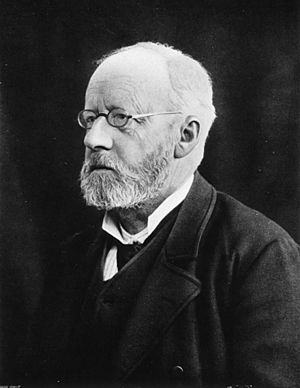Edwin Klebs facts for kids
Quick facts for kids
Edwin Klebs
|
|
|---|---|

Theodor Albrecht Edwin Klebs
|
|
| Born | 6 February 1834 |
| Died | 23 October 1913 (aged 79) Bern, Switzerland
|
| Nationality | German, Swiss |
| Alma mater | University of Würzburg University of Berlin University of Königsberg |
| Scientific career | |
| Fields | Pathology |
| Institutions | University of Bern University of Würzburg University of Prague University of Zurich Rush Medical College |
| Doctoral advisor | Rudolf Virchow |
| Doctoral students | Otto Lubarsch |
Theodor Albrecht Edwin Klebs (born February 6, 1834, died October 23, 1913) was a German-Swiss scientist who studied tiny living things, called a microbiologist. He is famous for his important work on infectious diseases, which are illnesses caused by germs.
His discoveries helped start modern bacteriology, the study of bacteria. He even inspired other famous scientists like Louis Pasteur and Robert Koch. Klebs was the first to find the specific bacterium that causes diphtheria, a serious illness. This bacterium was once called the Klebs–Loeffler bacterium, but its scientific name is now Corynebacterium diphtheriae.
Contents
Life Story of Edwin Klebs
Edwin Klebs was born in a city called Königsberg in what was then Province of Prussia. He began his studies in 1855 at the University of Würzburg. There, he learned from a very important doctor named Rudolf Virchow.
Klebs earned his doctorate degree from the University of Berlin in 1858. The next year, he completed his "habilitation" at the University of Königsberg. This meant he was qualified to teach at a university.
Early Career and Moving to Switzerland
From 1861 to 1866, Klebs worked as an assistant to Rudolf Virchow in Berlin. After that, he became a professor of pathology at the University of Bern in Switzerland. Pathology is the study of diseases.
While in Switzerland, he married a Swiss woman named Rosa Grossenbacher. He also became a Swiss citizen. In 1870, he served as a doctor for the Prussian Army during the Franco-Prussian War.
Teaching and Later Years
Klebs taught at several universities throughout his career. He taught in Würzburg from 1872 to 1873. Then he moved to Prague, where he taught from 1873 to 1882. After that, he taught at the University of Zürich from 1882 to 1892.
In 1893, Klebs left Zürich after some disagreements. He tried to start his own private business, but it was not successful. From 1896 to 1900, he taught in the United States at Rush Medical College in Chicago. Later, he returned to Europe and worked as a private researcher in Berlin. He spent his final years living with his oldest son in Lausanne, Switzerland, and passed away in Bern.
Key Discoveries in Medicine
Edwin Klebs made several important discoveries that changed how we understand diseases. He was a pioneer in the field of bacteriology.
Identifying the Diphtheria Bacterium
In 1883, Klebs successfully found the bacterium that causes diphtheria. This germ is known scientifically as Corynebacterium diphtheriae. It is also sometimes called the Klebs-Löffler bacillus in his honor.
Names Honoring Klebs
Two groups of living things are named after Edwin Klebs because of his important work:
- The bacterial group Klebsiella is named after him.
- Klebsormidium, a group of green algae with 20 different types, was also named in his honor in 1972.
Other Important Findings
Klebs made other discoveries that came before some very famous medical breakthroughs. For example, he described a condition called acromegaly in 1884. This was two years before another scientist, Pierre Marie, also described it.
He was able to grow groups of bacteria in a lab nine years before Robert Koch, another famous scientist. Klebs was also the first to show that tuberculosis could be given to animals. He did this by injecting them with milk from infected cows. He also identified the bacterium that causes typhoid fever, Salmonella typhi, before Karl Joseph Eberth.
Images for kids
See also
 In Spanish: Edwin Klebs para niños
In Spanish: Edwin Klebs para niños


